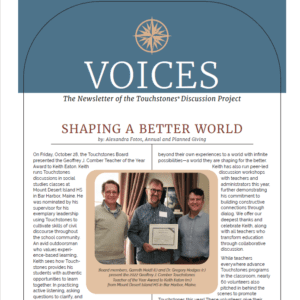3 Strategies for Addressing the Barriers to Participation in Class Discussions
By Brittany Usiak, K-12 and Adult Education Programs Manager
We’re kicking off the new year with a series of posts taking a closer look at The Four Stages of group development in Touchstones, starting with Participation. Work done in the initial Participation stage sets the foundation for more complex collaboration as a group develops. Building a space for truly inclusive classroom discussion takes time and practice. And with your guidance, students can establish the sense of trust and belonging with one another they need to participate fully and authentically.
There are many barriers that get in the way of this type of participation, especially when a group is just beginning to form. These common dynamics probably feel familiar to you, either as an educator leading discussions or from your own experience as a student: prolonged periods of silence, dominance by some members of the group, participants only responding to the teacher or leader’s prompts, or displays of disrespect such as ignoring someone’s point. These and other issues of participation can challenge the idea that everyone’s voice and opinions are valuable and make it difficult for participants to engage more deeply with each other.
As a discussion leader, your goal in the first stage is to establish an environment where every participant feels able to speak to and learn from peers. Below, we share a few strategies we’ve found especially valuable for cultivating this type of learning community.
1. Ask yourself whose voices are not being heard
Classroom discussions can easily end up just including a few students while everyone else stays silent. Many times we think of those more reluctant speakers as simply shy, but there are myriad reasons why students stay quiet and often a shift in your interventions can be what’s needed to help them feel comfortable sharing their views. Focus on those quieter students and differentiate your approach to making space for their voices, just as you do when students need support with content or skills in other areas of your class. For example, if you consistently don’t hear from a traditionally high achieving student who you know feels more comfortable analyzing text than sharing personal experiences, try posing a text-based question. Or if you know that a pair of students are particularly close, but one of them rarely speaks up, trying bringing in their friend first to make that student feel more at ease. Alternatively, if you have one especially dominant student who makes it difficult for others to feel heard, try inviting them to serve as a student observer so they can share their thoughts during the evaluation, while making room for others during the discussion itself.
2. Offer multiple modes and opportunities for engagement
As educators you already know that offering different modalities for engagement provides students with the choices they need to participate in a way that feels comfortable. In Touchstones, much of this differentiation is built into the program: students write down their thoughts during individual work, share verbally and feel less pressure with just a few peers during small group work, and reflect on their observations about group dynamics during the discussion evaluation. One shift you might consider reflecting on is how speaking is valued in your discussions compared to listening. The types of participation that we put a premium on as educators reinforces what students perceive as valuable. In many class discussions, speaking is often prioritized over listening. And while speaking is essential, we can practice noticing and affirming participation connected to active listening including body language that indicates engagement or asking clarifying questions.
3. Start with experience-based questions
When a discussion class is first beginning to form, it can be challenging to start off with textual analysis and exploration of ideas. We often suggest that discussion leaders begin by posing experience-based questions, which provide themes to consider that feel more readily accessible and less intimidating for many students. This might seem as if students are off-topic or off-text, especially during the first 6-8 lessons. If they are speaking to one another in a fruitful way, their engagement level is high, and they are somehow speaking to the topics of the text, they are right on target. As they strengthen their discussion skills over time, you can steer them more toward the text.
These strategies invite opportunities for greater participation from every student in your class while your students are also setting goals for improvement through discussion evaluations. As your group grows and builds trust throughout the year, they will feel confident and better prepared to engage in more textual analysis and sharing responsibility. Do you have other strategies you’ve used to foster greater participation? Tell us about them in the comments. If you’re interested in adding more strategies to your toolbox, join us for an upcoming workshop.
This post is the first in a series on The Four Stages of group development. Check back in February for the next post focusing on Cooperation.




 Join the
Join the